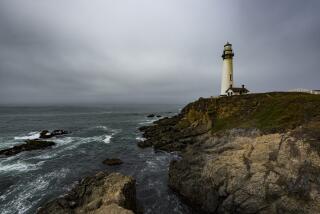Lost: ancient kingdom of the Cham
The driver spoke no English; my Vietnamese vocabulary was limited. But we were going to spend five days together driving along the central coast of Vietnam. Hand gestures and pointing at places on a map would have to work.
Before long, I had learned a valuable motto for travel here: “Things rarely go as planned, but everything usually turns out just fine.”
I was seeking the lost kingdom of Champa, a great maritime empire that once ruled much of what is now Vietnam. For 900 years, the Cham people controlled an independent state, but they fought often with their neighbors — the Vietnamese to the north and the Khmer to the south.
Little is known of the Cham, but their land was one of the more exotic places visited by Marco Polo on his legendary journeys in the late 13th century. Champa no longer exists by that name, but with a little imagination, it can still be seen along the central coast of Vietnam. A few temples, sensuous art and sculptures of Cham gods survive as testimony to this highly developed civilization. As a bonus, visitors can discover some of the finest scenery and beaches the country has.
I got hooked on the Cham culture a few years ago while visiting Nha Trang, a beach resort along the central coast that’s becoming popular with tourists.
I thought I knew Vietnam pretty well, having lived here for several years before the war, but Nha Trang startled me with its temples, which bore a strong resemblance to those at Angkor Wat in Cambodia.
So when I returned last March, I decided to add an excursion along the coast. Hiring a car and driver was inexpensive: I paid $75 a day, which included car, gas, driver and the driver’s lodging.
Though I had made arrangements with one of the better-known tour groups in Vietnam, no one showed up on the day of departure. After placing a few phone calls, the company hurriedly sent driver Doan Duc Hung from Hanoi in an Asian-model SUV.
Our starting point was the ancient town of Hoi An, now a popular stop for Western tourists. It was an important port in the time of the Cham, receiving Chinese emissaries and traders from faraway lands. After the Viet lords vanquished the Cham and began to move into the region in the 17th century, they used the town for their dealings with Japanese, Chinese and Western traders.
These days most visitors come by land rather than by sea, and they find their tastes catered to with dozens of handicraft shops and many restaurants, including one called Champa.
Our first stop was the Cham Museum in the nearby city of Da Nang, where an open-air building contains a large collection of sculptures recovered from the temples. I recognized old familiars from the Hindu pantheon, including Ganesh, the elephant-head god, Siva, Vishnu and Uma, as well as fanciful sea monsters and lion-elephants (gajasimha) unique to the Cham.
Much of it was exquisite; it was especially fascinating when compared to the Khmer sculptures from Angkor and other sites in Cambodia. The Khmer and the Cham took turns capturing each other’s capitals, evidently exchanging culture in the process.
Thirty miles south of Da Nang, we found the sanctuary of My Son, the oldest and most famous of the Cham sites. The Cham built it in a remote valley far out of harm’s way, and its complex of temples, begun long before Angkor in Cambodia, survived well into the 20th century. Then came the Vietnam War and B-52 bombers that had no trouble visiting remote valleys. My Son had become a hideout for Viet Cong, and in 1969, the central temples in each group — including most of the masterworks of the Cham culture — were destroyed.
However, the remaining buildings and the setting are still worth a trip and were designated a World Heritage Site by UNESCO in the 1990s.
The roads to My Son are narrow but paved, finally ending near a small stream that curls around the temples. The footpath from the visitors’ center makes a circuit, which I walked in the reverse direction. This had the advantage of taking me through the most damaged areas first, and I was able to finish on a high note with the temples that are still standing.
Two of the buildings house a collection of sculptures and other temple ornaments, including a wonderful dancing Siva.
Green fields, royal courts
Traveling south from My Son on Highway 1 — the nation’s main north-south artery — we saw a fresh palette of colors: green fields dotted with white egrets and bordered by groves of palm trees. In the distance to our right was the range of mountains that make up the Central Highlands. On the road in front of us was an endless parade of bicycles and mopeds carrying a range of produce and merchandise. Golden rice was spread out along the roadside to dry or was mounded for collection.About 100 miles south of Hoi An, the road crossed a series of passes through the hills that once protected Vijaya, onetime capital of the Cham kingdom. The citadel of Cha Ban is about half a mile from the main highway and was at the top of my list. This is where Marco Polo visited the royal court and found the king of the Cham, who was said to have more than 300 children.
Many battles were fought here among the warlike Cham, the Viets and the Khmer. Cha Ban was the site of a dramatic siege in 1377, when a Viet army was lured to its destruction and its king killed. One hundred years later, the Viets breached the walls of the citadel, putting tens of thousands of its occupants to the sword and ending the Cham’s supremacy forever.
Although many of the sculptures in the Cham Museum were found here, only a single temple tower remains of the ancient city. The aging Vietnamese cemetery across the road strikes an appropriately melancholy chord.
The port of Qui Nhon is not far away, and it’s the best place to pause on the long drive south from Hoi An. It is a large, modern city but is visited by few Westerners. I stood out at the Seagull, a large hotel that caters to Asian business travelers and, that evening at least, an enormous wedding party.
Leaving Qui Nhon, we found the road again bordered by the rich green of rice fields. After about 70 miles, the highway crossed another minor mountain range and passed through a region of enchanting peninsulas and offshore islands that reminded me of the California coastline. From there it descended into the town of Nha Trang, a popular destination for scuba divers and tourists.
It was a good stop on my search for Cham heritage. Nha Trang apparently was an important center of the kingdom, because the Cham built six towers here.
Four of them survive, including the main temple, which was crowded with Vietnamese paying their respects to Po Nagar (the Lady of the City), a mythological earth mother with 99 husbands and 37 daughters. The temple overlooks the mouth of the Cai River, which was packed with fishing boats.
Nha Trang has a beautiful curving beach and a protected bay. There are many affordable hotels and guesthouses in town for tourists and divers, but I treated myself to the pricey oceanfront Ana Mandara Resort. Through its gates, one finds a different world — elegant modern bungalows in a secluded garden setting with an impeccably courteous Japanese staff.
South of Nha Trang, the scenery became dry and barren as we entered Panduranga province, the last realm of the Cham. The color palette shifted into ochre and brown with nary a rice stalk to be seen. The French called this region the “Iron Coast.”
Several reminders of the glory days of Champa can be seen here. Near Phan Rang, there are the 8th century towers of Hoa Lai and the well-preserved temple and three ruddy red towers of Po Klong Garai. The towers, which are near the main road, make a particularly dramatic impression, perched on a steep hill against a blue sky.
Po Ro Me is a little harder to find, though it’s just a few miles west of the town of Phuoc Dan. It’s worth the effort. From the lonely hilltop where it was built, visitors get a breathtaking view of the surrounding chaparral.
The temple is dedicated to Po Ro Me, the last of the Cham kings. Legend has it that he could not resist the charms of a Vietnamese princess, who tricked him into cutting down a sacred tree, leading to the fall of the kingdom. He died a Vietnamese prisoner.
Beaches and golf
About two hours after getting back on Highway 1, we arrived at the golf and beach resorts at Phan Thiet. Visitors here can choose among myriad midrange beach bungalow complexes at Mui Ne Beach, along a sandy drive that could have been on North Carolina’s Outer Banks. Germans and Swiss seemed to be the most frequent visitors, although many Vietnamese were here, too, joining foreigners for some beach time.On the last morning of my tour, I paid a visit to the southernmost surviving Cham towers, Po Sanu (also known as Phu Hai), which strike a nice pose on the ridgeline of a coastal hill just south of the resort area. These 8th century temples dedicated to two daughters of Po Nagar are plain, but their location offers great vistas of the sea, and they are close enough to Saigon to attract many tourist buses.
I left the two daughters with a bit of sadness, knowing that my expedi- tion was at an end. The Cham retreated from here to the west, many of them settling in villages near the Cambodian border, where some now worship Allah and build mosques instead of towers. I had passed out of the magical land of Champa.
*
(BEGIN TEXT OF INFOBOX)
Vietnam’s central coastline
GETTING THERE:
From LAX to Da Nang, connecting service (change of planes) is available on Singapore, EVA or Malaysia. Restricted round-trip fares begin at $1,440.
TELEPHONES:
To call the numbers below from the U.S., dial 011 (the international dialing code), 84 (country code for Vietnam) and the local number.
TOUR COMPANIES:
Exotissimo, Saigon Trade Center, 37 Ton Duc Thang, District 1, Ho Chi Minh City; 4-828-2150, https://www.exotissimo.com . Custom and established tours throughout Indochina.
VeloAsia, 1283 12th Ave., San Francisco, CA; (888) 833-4533 or (415) 731-3360, https://www.veloasia.com . Bicycle tours include a “Highlights” tour that covers the central coast from Hue to Phan Rang.
WHERE TO STAY:
Hoi An Hotel, 06 Tran Hung Dao St., Hoi An Town; 510-861-373, https://www.hoiantourist.com . This hotel, conveniently located adjacent to the historic district, is made up of a group of modern colonial-style buildings in an attractive setting. As a state-run hotel, it’s always proper, if a little formal. Doubles $42.
Seagull Hotel (Hai Au Hotel), 489 Nguyen Hue St., Quy Nhon; 56-846-473, https://www.seagullhotel.com.vn or https://www.vietnamhotels.biz/seagull . This hotel, located on the beach, is older but serviceable. Doubles $45.
Ana Mandara Resort, Beachside Tran Phu Boulevard, Nha Trang; 58-829-829, https://www.sixsenses.com . Modern bungalow complex has manicured lawns, a well-groomed private beach, and all the other amenities you’d expect for the price. Doubles from $194 a night.
WHERE TO EAT:
L’Ocean, Victoria Phan Thiet Resort, Kilometer 9, Phu Hai, Phan Thiet; 62-813-000, https://www.victoriahotels-asia.com . The Victoria hotel chain has elegant neocolonial hotels at strategic tourist destinations in Vietnam. L’Ocean is lovely and overlooks the water. Vietnamese and American food. Entrees about $10.
Han Huyen Floating Restaurant, Bach Dang Street, Hoi An; 510-861-462. This on-the-river restaurant specializes in Chinese and Vietnamese dishes.
TO LEARN MORE:
Embassy of Vietnam, (202) 861-0737, https://www.vietnamembassy-usa.org .
— Mike High
More to Read
Sign up for The Wild
We’ll help you find the best places to hike, bike and run, as well as the perfect silent spots for meditation and yoga.
You may occasionally receive promotional content from the Los Angeles Times.






